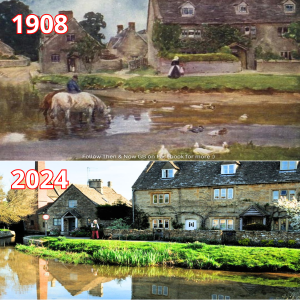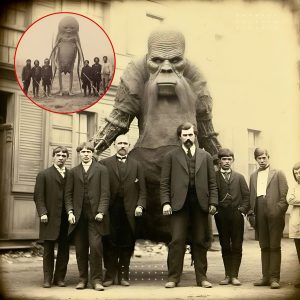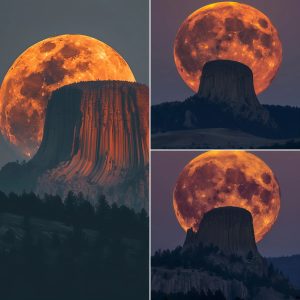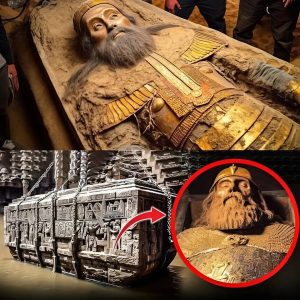
Lower Slaughter, nestled in the heart of the Cotswolds, is one of England’s most picturesque villages. Known for its honey-colored stone cottages and the tranquil River Eye that meanders through it, the village has been a source of inspiration for artists for centuries. One of the most notable depictions of Lower Slaughter is by the artist Nicholls George Franck, who captured the village’s charm in a beautiful painting in 1908. This article explores how Franck’s representation of Lower Slaughter compares to its present-day appearance, highlighting the village’s enduring beauty and timeless atmosphere.
Franck’s 1908 Painting: A Glimpse of Timeless Serenity
In his 1908 painting, Nicholls George Franck masterfully portrays Lower Slaughter as a tranquil and idyllic English village. The cottages, built from the region’s famous honey-colored limestone, line the narrow streets, exuding warmth and timelessness. Their thatched roofs and distinctive architectural style speak of centuries-old craftsmanship. The River Eye, a gentle stream that winds through the heart of the village, reflects the cottages and the surrounding greenery, creating a mirror-like effect that enhances the painting’s peaceful atmosphere.
Franck’s work captures a moment of serenity in Lower Slaughter, with no signs of modernization or disruption. The village seems to exist in a world of its own, untouched by the industrial changes happening elsewhere in the country. The painting reflects the Cotswolds’ reputation as a region where time seems to stand still, with its pastoral beauty and slow pace of life preserved for generations.
Lower Slaughter Today: A Village Preserved in Time
More than a century after Franck’s painting, Lower Slaughter remains remarkably similar in appearance. The honey-colored cottages, which are the hallmark of Cotswolds architecture, continue to define the village’s character. While some of the thatched roofs have been replaced with slate, the overall look and feel of the village have been carefully maintained through preservation efforts.
Walking through Lower Slaughter today, it is easy to feel as though you’ve stepped into Franck’s painting. The River Eye still winds gracefully through the village, with stone footbridges crossing its gentle flow. The sound of water trickling over the mill’s waterwheel adds to the sense of calm that pervades the village, just as it would have in Franck’s time. The narrow streets are lined with flowers and greenery, enhancing the beauty of the honey-colored stone and creating an enchanting scene reminiscent of the early 20th century.
Changes and Continuities: Modern Life in an Ancient Setting
While Lower Slaughter’s appearance has remained largely unchanged, modern life has subtly made its mark on the village. Today, Lower Slaughter is a popular destination for tourists seeking to experience the quintessential Cotswolds charm. As a result, many of the historic cottages have been converted into boutique hotels, cafes, and guesthouses, catering to visitors from around the world.
However, these changes have been done with great care, ensuring that the village’s historical character is preserved. New developments are restricted, and any renovations must adhere to strict guidelines to maintain the architectural integrity of the village. The result is a delicate balance between preserving Lower Slaughter’s past and accommodating the needs of the present.
Despite the increase in visitors, Lower Slaughter retains its peaceful atmosphere. The village’s small size and the absence of large commercial developments help to keep the crowds at bay, particularly during quieter times of the year. This means that much of the serenity Franck captured in his painting still exists today, especially in the early mornings or late afternoons when the village is bathed in soft, golden light.
A Living Museum: The Enduring Appeal of Lower Slaughter
What makes Lower Slaughter so unique is its ability to feel like a living museum. Visitors can walk through its streets and feel as though they are stepping back in time. The River Eye still glides gently through the village, just as it did in Franck’s painting. The honey-colored stone cottages remain, their beauty enhanced by the passage of time rather than diminished. Even the village’s iconic mill, now a museum and gift shop, continues to evoke a sense of history and tradition.
In many ways, Lower Slaughter has been able to preserve not just its physical appearance, but also the essence of the peaceful, rural life that Franck depicted over a century ago. This is a testament to the village’s commitment to conservation and its understanding of the importance of maintaining its historical identity in a rapidly changing world.
Conclusion: Lower Slaughter’s Timeless Beauty
Nicholls George Franck’s 1908 painting of Lower Slaughter offers a glimpse into a village that has largely remained unchanged for over a century. Today, visitors to Lower Slaughter can still experience the same tranquil atmosphere and architectural beauty that Franck captured in his work. The village’s honey-colored cottages and the serene flow of the River Eye continue to define its character, making it one of the most picturesque and well-preserved villages in the Cotswolds.
While modern tourism has brought some changes to the village, these have been carefully managed to ensure that Lower Slaughter retains its historical charm. For those who visit, the village offers not just a beautiful landscape, but also a connection to the past—a chance to experience a place where time truly seems to stand still.





